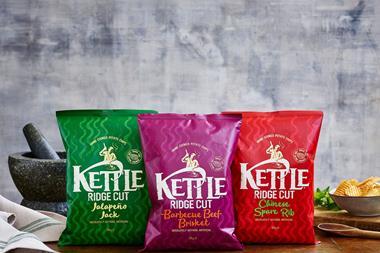Tesco is rolling out wheeled merchandising units to its bread and beer fixtures in a bid to increase availability and cut down on costs.
The retailer is running trials across both fixtures, using rolling pallets that are simply pushed into place. Once emptied by shoppers, they are then rolled off the shopfloor and replaced with new ones.
Although designed to ensure that product completes the final and vital 50 yards of its journey, the move has received a mixed reception from suppliers who claim they are shouldering the cost of the exercise.
One major brewer said it was working closely with Tesco, which is introducing the system to around 250 of its biggest stores, but that it had concerns over the cost implications.
A senior source said: “It is
wonderful for Tesco but it is a pain for us.
“The principle is great because it is about improving availability and gets over the age-old problem of the last 50 yards and delivers a whopping great cost saving for the retailer.
“But from a supplier’s perspective, it is not so good. If the margin you get for your products is acceptable, then you might be able to make it wash, but if the margin structure is very tight then it is going to cost suppliers a lot of money.”
The main problem, said the source, was that the units were only equivalent to half pallets, meaning manual labour was needed to load them in plants geared up to filling up whole pallets on automated lines. He added: “If this becomes an industry standard across all the major retailers then investment in new systems may be worth it, but that is a long way off.”
One baker also involved in the Tesco trials said it had to draft in manual labour to its loading bays.
The Federation of Bakers said some members had been working with Tesco across 50 stores to investigate the “feasibility of a common industry bread basket”. An initial trial had already led to a redesign, which will be further tested later this year.
A Tesco spokesman said: “These innovations are always joint initiatives carried out in partnership with our suppliers. There are benefits for both retailer and supplier with increased availability resulting in an increase in sales.”
Simon Mowbray
The retailer is running trials across both fixtures, using rolling pallets that are simply pushed into place. Once emptied by shoppers, they are then rolled off the shopfloor and replaced with new ones.
Although designed to ensure that product completes the final and vital 50 yards of its journey, the move has received a mixed reception from suppliers who claim they are shouldering the cost of the exercise.
One major brewer said it was working closely with Tesco, which is introducing the system to around 250 of its biggest stores, but that it had concerns over the cost implications.
A senior source said: “It is
wonderful for Tesco but it is a pain for us.
“The principle is great because it is about improving availability and gets over the age-old problem of the last 50 yards and delivers a whopping great cost saving for the retailer.
“But from a supplier’s perspective, it is not so good. If the margin you get for your products is acceptable, then you might be able to make it wash, but if the margin structure is very tight then it is going to cost suppliers a lot of money.”
The main problem, said the source, was that the units were only equivalent to half pallets, meaning manual labour was needed to load them in plants geared up to filling up whole pallets on automated lines. He added: “If this becomes an industry standard across all the major retailers then investment in new systems may be worth it, but that is a long way off.”
One baker also involved in the Tesco trials said it had to draft in manual labour to its loading bays.
The Federation of Bakers said some members had been working with Tesco across 50 stores to investigate the “feasibility of a common industry bread basket”. An initial trial had already led to a redesign, which will be further tested later this year.
A Tesco spokesman said: “These innovations are always joint initiatives carried out in partnership with our suppliers. There are benefits for both retailer and supplier with increased availability resulting in an increase in sales.”
Simon Mowbray














No comments yet